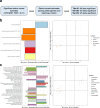Genetic influences on circulating retinol and its relationship to human health
- PMID: 38374065
- PMCID: PMC10876955
- DOI: 10.1038/s41467-024-45779-x
Genetic influences on circulating retinol and its relationship to human health
Abstract
Retinol is a fat-soluble vitamin that plays an essential role in many biological processes throughout the human lifespan. Here, we perform the largest genome-wide association study (GWAS) of retinol to date in up to 22,274 participants. We identify eight common variant loci associated with retinol, as well as a rare-variant signal. An integrative gene prioritisation pipeline supports novel retinol-associated genes outside of the main retinol transport complex (RBP4:TTR) related to lipid biology, energy homoeostasis, and endocrine signalling. Genetic proxies of circulating retinol were then used to estimate causal relationships with almost 20,000 clinical phenotypes via a phenome-wide Mendelian randomisation study (MR-pheWAS). The MR-pheWAS suggests that retinol may exert causal effects on inflammation, adiposity, ocular measures, the microbiome, and MRI-derived brain phenotypes, amongst several others. Conversely, circulating retinol may be causally influenced by factors including lipids and serum creatinine. Finally, we demonstrate how a retinol polygenic score could identify individuals more likely to fall outside of the normative range of circulating retinol for a given age. In summary, this study provides a comprehensive evaluation of the genetics of circulating retinol, as well as revealing traits which should be prioritised for further investigation with respect to retinol related therapies or nutritional intervention.
© 2024. The Author(s).
Conflict of interest statement
P.S. is now a full-time employee of GlaxoSmithKline. The remaining authors declare no competing interests.
Figures





References
MeSH terms
Substances
Grants and funding
- MR/L003120/1/MRC_/Medical Research Council/United Kingdom
- 1188493/Department of Health | National Health and Medical Research Council (NHMRC)
- MR/S003746/1/MRC_/Medical Research Council/United Kingdom
- WT_/Wellcome Trust/United Kingdom
- 1121474/Department of Health | National Health and Medical Research Council (NHMRC)
LinkOut - more resources
Full Text Sources
Medical
Research Materials
Miscellaneous

